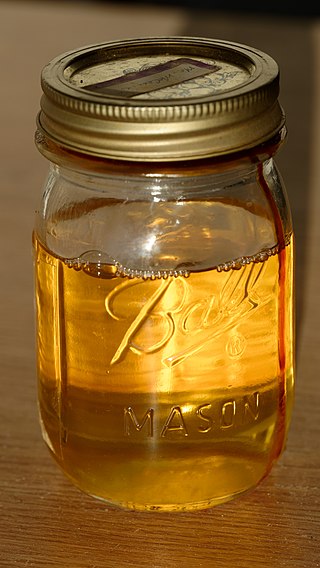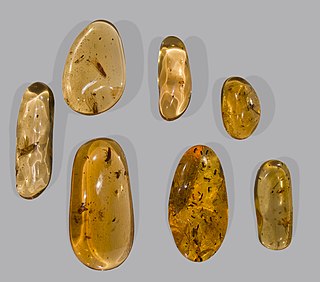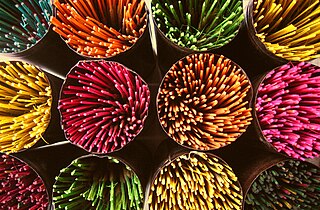
Amber is fossilized tree resin that has been appreciated for its color and natural beauty since Neolithic times. Much valued from antiquity to the present as a gemstone, amber is made into a variety of decorative objects. Amber is used in jewelry and has been used as a healing agent in folk medicine.

Paint is any pigmented liquid, liquefiable, or solid mastic composition that, after application to a substrate in a thin layer, converts to a solid film. It is most commonly used to protect, color, or provide texture. Paint can be made in many colors—and in many different types. Paint is typically stored, sold, and applied as a liquid, but most types dry into a solid. Most paints are either oil-based or water-based and each has distinct characteristics. For one, it is illegal in most municipalities to discard oil-based paint down household drains or sewers. Clean-up solvents are also different for water-based paint than they are for oil-based paint. Water-based paints and oil-based paints will cure differently based on the outside ambient temperature of the object being painted Usually, the object being painted must be over 10 °C (50 °F), although some manufacturers of external paints/primers claim they can be applied when temperatures are as low as 2 °C (35 °F).

Lac is the resinous secretion of a number of species of lac insects, of which the most commonly cultivated is Kerria lacca.

Shellac is a resin secreted by the female lac bug on trees in the forests of India and Thailand. It is processed and sold as dry flakes and dissolved in alcohol to make liquid shellac, which is used as a brush-on colorant, food glaze and wood finish. Shellac functions as a tough natural primer, sanding sealant, tannin-blocker, odour-blocker, stain, and high-gloss varnish. Shellac was once used in electrical applications as it possesses good insulation qualities and it seals out moisture. Phonograph and 78 rpm gramophone records were made of it until they were replaced by vinyl long-playing records from 1948 onwards.

In polymer chemistry and materials science, resin is a solid or highly viscous substance of plant or synthetic origin that is typically convertible into polymers. Resins are usually mixtures of organic compounds. This article focuses on naturally occurring resins.

Turpentine is a fluid obtained by the distillation of resin harvested from living trees, mainly pines. Mainly used as a specialized solvent, it is also a source of material for organic syntheses.

Copal is tree resin, particularly the aromatic resins from the copal tree Protium copal (Burseraceae) used by the cultures of pre-Columbian Mesoamerica as ceremonially burned incense and for other purposes. More generally, copal includes resinous substances in an intermediate stage of polymerization and hardening between "gummier" resins and amber. Copal that is partly mineralized is known as copaline.

Varnish is a clear transparent hard protective coating or film. It is not a stain. It usually has a yellowish shade from the manufacturing process and materials used, but it may also be pigmented as desired, and is sold commercially in various shades.

Lacquer is a type of hard and usually shiny coating or finish applied to materials such as wood or metal. It is most often made from resin extracted from trees and waxes and has been in use since antiquity.

Rosin, also called colophony or Greek pitch, is a solid form of resin obtained from pines and some other plants, mostly conifers, produced by heating fresh liquid resin to vaporize the volatile liquid terpene components. It is semi-transparent and varies in color from yellow to black. At room temperature rosin is brittle, but it melts at stove-top temperature. It chiefly consists of various resin acids, especially abietic acid. The term colophony comes from colophonia resina, Latin for "resin from Colophon", an ancient Ionic city.

Balsam is the resinous exudate which forms on certain kinds of trees and shrubs. Balsam owes its name to the biblical Balm of Gilead.

Dammar, also called dammar gum, or damar gum, is a resin obtained from the tree family Dipterocarpaceae in India and Southeast Asia, principally those of the genera Shorea or Hopea. The resin of some species of Canarium may also called dammar. Most is produced by tapping trees; however, some is collected in fossilised form on the ground. The gum varies in colour from clear to pale yellow, while the fossilised form is grey-brown. Dammar gum is a triterpenoid resin, containing many triterpenes and their oxidation products. Many of them are low molecular weight compounds, but dammar also contains a polymeric fraction, composed of polycadinene. The name dammar is a Malay word meaning ‘resin’ or ‘torch made from resin’.

Onycha, along with equal parts of stacte, galbanum, and frankincense, was one of the components of the consecrated Ketoret (incense) which appears in the Torah book of Exodus (Ex.30:34-36) and was used in the Jerusalem's Solomon's Temple. This formula was to be incorporated as an incense, and was not to be duplicated for non-sacred use. What the onycha of antiquity actually was cannot be determined with certainty. The original Hebrew word used for this component of the ketoret was שחלת, shecheleth, which means "to roar; as a lion " or “peeling off by concussion of sound." Shecheleth is related to the Syriac shehelta which is translated as “a tear, distillation, or exudation.” In Aramaic, the root SHCHL signifies “retrieve.” When the Torah was translated into Greek the Greek word “onycha” ονυξ, which means "fingernail" or "claw," was substituted for shecheleth.

French polishing is a wood finishing technique that results in a very high gloss surface, with a deep colour and chatoyancy. French polishing consists of applying many thin coats of shellac dissolved in denatured alcohol using a rubbing pad lubricated with one of a variety of oils. The rubbing pad is made of absorbent cotton or wool cloth wadding inside of a piece of fabric and is commonly referred to as a fad, also called a rubber, tampon, or muñeca.

Kauri gum is resin from kauri trees, which historically had several important industrial uses. It can also be used to make crafts such as jewellery. Kauri forests once covered much of the North Island of New Zealand, before the arrival of people caused deforestation, causing several areas to revert to sand dunes, scrubs, and swamps. Even afterwards, ancient kauri fields continued to provide a source for the gum and the remaining forests.

Hymenaea courbaril, the courbaril or West Indian locust, is a tree common in the Caribbean, Central America, and South America. It is a hardwood that is used for furniture, flooring, and decoration. Its hard fruit pods have edible dry pulp surrounding the seeds. Its sap, called animé, is used for incense, perfume, and varnish.

In India, incense sticks, called Agarbatti, are a large part of the economy and many religions in the region.

Styrax benzoin is a species of tree native to Sumatra in Indonesia. Common names for the tree include gum benjamin tree, loban (in Arabic), kemenyan (in Indonesia and Malaysia), onycha, and Sumatra benzoin tree.

Mastic is a resin obtained from the mastic tree. It is also known as tears of Chios, being traditionally produced on the island Chios, and, like other natural resins, is produced in "tears" or droplets.
The conservation and restoration of lacquerware prevents and mitigates deterioration or damage to objects made with lacquer. The two main types of lacquer are Asian, made with sap from the Urushi tree, and European, made with a variety of shellac and natural resins. Lacquer can be damaged by age, light, water, temperature, or damaged substrate.


















